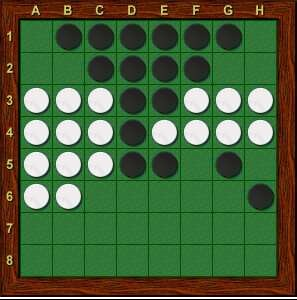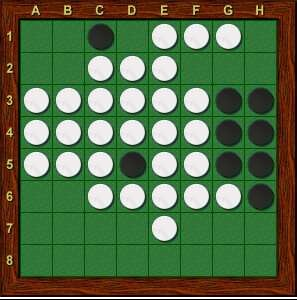Fang: Simple Midgame Advice: Unterschied zwischen den Versionen
Keine Bearbeitungszusammenfassung |
Keine Bearbeitungszusammenfassung |
||
| Zeile 1: | Zeile 1: | ||
{|style="width: 100%;" | {|style="width: 100%;" | ||
| colspan="2" style="text-align:right;"|[[Fang: | | colspan="2" style="text-align:right;"|[[Fang:_Othello_Grundlagen|Klicke hier für die '''deutsche Version''']] [[Datei:ger.png|30px|link=Fang:_Mittelspiel|Deutsche Sprache]] | ||
|- | |- | ||
| style="width: 60%"|'''Navigation: [[Hauptseite| | | style="width: 60%"|'''Navigation: [[Hauptseite|Main Page]] > [[Othello_lernen|Learn Othello]] > [[Othello_Book_of_Randy_Fang|Book Fang]]''' | ||
| style="width: 40%" style="text-align:right;"| '''[[Fang: | | style="width: 40%" style="text-align:right;"| '''[[Fang:_Simple_Opening_Advice | << previous chapter <<]] - [[Fang:_Simple_Endgame_Advice| >> next chapter >>]]''' | ||
|} | |} | ||
---- | ---- | ||
| Zeile 177: | Zeile 177: | ||
{|style="width: 100%;" | {|style="width: 100%;" | ||
| style="width: 60%"|'''Navigation: [[Hauptseite|Hauptseite]] > [[Othello_lernen|Learn Othello]] > [[Othello_Buch_von_Randy_Fang|Buch Fang]]''' | | style="width: 60%"|'''Navigation: [[Hauptseite|Hauptseite]] > [[Othello_lernen|Learn Othello]] > [[Othello_Buch_von_Randy_Fang|Buch Fang]]''' | ||
| style="width: 40%" style="text-align:right;"| '''[[Fang: | | style="width: 40%" style="text-align:right;"| '''[[Fang:_Simple_Opening_Advice | << previous chapter <<]] - [[Fang:_Simple_Endgame_Advice| >> next chapter >>]]''' | ||
|} | |} | ||
Version vom 24. Dezember 2023, 16:19 Uhr
| Klicke hier für die deutsche Version | |
| Navigation: Main Page > Learn Othello > Book Fang | << previous chapter << - >> next chapter >> |
- It’s all about mobility
- Tempo
As we’ve noticed in the previous sections, having and keeping mobility is a very important thing. When you run out of mobility it’s very likely that your opponent is going to force you to give up a corner and they will win. In the midgame, your job is usually to avoid running out of mobility while retaining a good position and trying to run your opponent out of mobility in return. Often, you will find that there are moves that you are forced to play or your opponent will run you out of mobility. Most of the time when I refer to a move as being a forced move, it means that the move must be played to prevent the other player from attaining a killer sequence. Obviously, if there is only one valid move on the board it is also a forced move. Let’s take a look at a position where one of the players has a forced move.

|

|

|
| BLACK PLAYS F1 | BLACK PLAYS B1 | BLACK PLAYS G1 |
Another common example of a forced move is when your opponent is threatening to take a corner and you have to play a certain move to prevent that from happening. Let’s look at an example:
From the above examples, it’s easy to see that a lot of times we will be forced to take edges in order to prevent our opponent from gaining enough tempo to run us out of mobility or to prevent them from taking corners.
Often, when we’re looking for a killer sequence, we are looking for a way to win a single tempo because if we win a single tempo our opponent runs out of safe moves.

|

|

|
| BLACK PLAYS D1 | WHITE PLAYS B1 (FORCED) | BLACK PLAYS F2 AND WINS |
Because Othello is a game where you often want to pass in order to improve your position , winning tempo from your opponent and not losing any tempo in return will often go a long way towards winning a game.
Exercises:
| 1. | 2. | |

|

| |
| BLACK TO PLAY AND GAIN TEMPO | WHAT IS WHITE’S FORCED NEXT MOVE? |
| 3. | 4. | |

|

| |
| WHITE TO PLAY AND WIN | WHITE TO PLAY AND WIN |
Answers:
| 1. Black plays G1.
2. White plays B1 (otherwise Black wins tempo with G1 and then B1). |
3. | 4. |

|

|
| Navigation: Hauptseite > Learn Othello > Buch Fang | << previous chapter << - >> next chapter >> |







